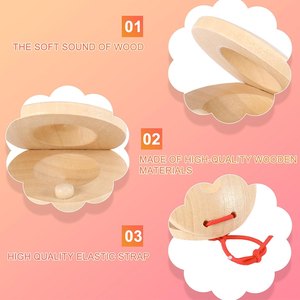
All categories
Featured selections
Trade Assurance
Buyer Central
Help Center
Get the app
Become a supplier

(8052 products available)



















































There is a wide range of percussion instruments for kids that are suitable for different age groups and skill levels. These instruments not only provide entertainment but also help in the cognitive, physical, and social development of children. Here are some common types:
Shakers and rattles
These are ideal for very young children. They are easy to hold and play by shaking. Examples include maracas, sand shakers, and egg shakers.
Drums
Children's drums come in various sizes and types. They range from hand drums like bongos and congas to snare and kick drums from a drum set. Smaller versions like the Remo Kids Percussion Bongo Drum are perfect for preschoolers.
Tambourines
These are simple and fun to play. They can be struck with hands or sticks to produce jingling sounds. They are often used in bands to add rhythm.
Xylophones and glockenspiels
These are percussion instruments with keys. They produce melodic tunes when the keys are struck with mallets. They are great for helping children understand music scales and melody.
Wood blocks and beaters
They produce a sharp, clicky sound when struck with a stick. They are often used in educational settings to teach children about rhythm and tempo.
Steel tongue drums
These are similar to hang drums but easier to play. They have a calming sound and can be used by kids to make music or beats. They are also suitable for adults.
Cajóns
These are box-shaped percussion instruments. Kids can sit on them and strike the front panel to produce various sounds. They are great for introducing children to different drum rhythms.
Electronic percussion instruments
These are modern instruments with built-in speakers. They produce different percussion sounds when the pads are struck. Some have educational features like pre-set rhythms and songs.
Mini percussion instruments for kids find diverse applications across various fields. Their compact size and user-friendly design make them suitable for different contexts. Here are some key application scenarios:
When selecting percussion instruments for children, several important factors should be considered to ensure that the instruments are appropriate, engaging, and conducive to the child's musical development. Here are some key points to keep in mind:
Age Appropriateness
It is crucial to select instruments that are suitable for the child's age. For younger children, it is advisable to choose small percussion instruments that are safe and can be easily manipulated. On the other hand, older children can handle more complex instruments.
Safety
Child safety should be a top priority when selecting musical instruments. Ensure that there are no sharp edges on the instruments and that they are free of small parts that could pose a choking hazard. Additionally, check that they are manufactured with non-toxic materials.
Durability
Given that children may not handle instruments delicately, it is essential to choose instruments made from durable materials that can withstand regular use and occasional rough handling.
Size and Weight
Select lightweight and compact instruments that are easy for children to hold and carry. Consider instruments that can be adjusted to fit the child's size, such as a small drum set or a xylophone for kids.
Variety and Engagement
To keep children interested and engaged, consider a variety of instruments that offer different sounds and playing techniques. A percussion instrument set can be an excellent choice as it provides multiple instruments, allowing children to explore and experiment with different playing styles.
Educational Value
Instruments that come with educational materials, such as songbooks, lesson guides, or access to online tutorials, can help children learn basic playing techniques and music theory. These resources can enhance their musical experience and provide a structured learning environment.
Sound Quality
Even though the instruments are intended for children, it is still essential to ensure they produce a good-quality sound. High-quality percussion instruments will have better sound quality, which can help children develop their musical ear and skills.
Kids' percussion instruments are mainly used to introduce children to the basics of music, such as rhythm and tempo. These instruments help children express themselves creatively.
Q1: What are the ideal percussion instruments for younger children?
A1: For younger children, it is best to choose simple and safe percussion instruments. For example, shakers, tambourines, and small drums with large drumsticks are suitable for children aged 3 to 5 years. These instruments are easy to hold and play, allowing young kids to explore rhythm and make music while having fun. In addition, older children can use xylophones and hand drums, which can help them develop better motor skills.
Q2: How can parents encourage their child's interest in percussion instruments?
A2: Parents can encourage their child's interest in percussion instruments in many ways. For example, by playing with them and demonstrating how to use the instruments, they can make the activity more exciting and engaging. In addition, they can create a "music playtime" routine by setting aside time each day for their child to play with the instruments. More importantly, they should praise their child's efforts and creativity, which will help boost their self-esteem and encourage them to continue making music.
Q3: Are there any recommended brands for percussion instruments for kids?
A3: Some of the most popular brands that produce quality percussion instruments for kids include Hape, Melissa & Doug, Remo, and Janod. These brands are known for their well-made, durable, and safe instruments designed for children.
Q4: How can teachers incorporate percussion instruments into the classroom?
A4: Teachers can incorporate percussion instruments into the classroom in many ways. For example, by using them during music lessons to teach rhythm, beat, and tempo. In addition, they can use the instruments during storytime to create sound effects and bring the stories to life. More importantly, teachers can use percussion instruments during group activities to promote teamwork and cooperation.